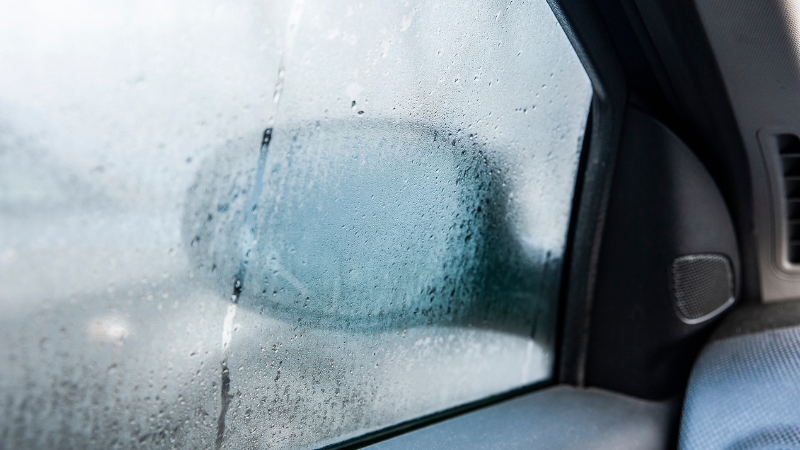Driving during the rainy season can be challenging, especially when your car windows start fogging up. This common problem is caused by the difference in temperature and humidity levels inside and outside the vehicle. Foggy windows not only reduce visibility but also increase the risk of accidents. To ensure a safe and comfortable drive during the rainy season, it is crucial to know how to prevent and deal with window fogging effectively. In this article, we will explore the reasons behind foggy windows and practical methods to prevent it.
Why Do Car Windows Fog Up During Rain?
Fogging on car windows occurs when the moist, warm air inside the car comes into contact with the cooler glass surface. This process causes condensation, forming a layer of fog on the windows. During the rainy season, the high humidity levels exacerbate this problem, especially when the car’s interior is warm due to passengers or the climate control system.
There are two types of fogging:
- Interior Fogging: Caused by the moisture inside the car, usually due to wet clothes, shoes, or breathing.
- Exterior Fogging: Occurs when the outside air is cooler than the warm air inside the car.
Understanding these factors will help you choose the right method to tackle the fogging issue.
Tips to Prevent Fogging on Car Windows
1. Use the Defogger and AC Simultaneously
Most modern cars come equipped with a defogger button that activates both the AC and the heater. This combination helps to maintain a balance between temperature and humidity inside the car. The AC removes excess moisture from the air, while the heater warms the glass, preventing condensation.
To use the defogger effectively:
- Turn on the AC and set it to the lowest temperature.
- Gradually increase the temperature while keeping the blower directed towards the windshield.
- Use the recirculation mode initially, then switch to the fresh air mode once the fog starts clearing.
2. Keep Your Car’s Interior Dry
One of the primary causes of fogging is moisture within the car cabin. To minimize interior humidity:
- Wipe off any water from wet clothes or umbrellas before getting inside.
- Use waterproof mats to avoid moisture seeping into the carpets.
- Keep the windows slightly open for ventilation when parked, especially after a rainy drive.
3. Use Anti-Fog Solutions
Anti-fog sprays and wipes are readily available and can be applied to the interior of the windows. These solutions create a thin, transparent layer that prevents moisture from condensing on the glass. Applying the solution before the onset of the rainy season will keep your windows fog-free.
Steps to apply:
- Clean the windows thoroughly to remove any dust or grime.
- Spray the anti-fog solution on a clean cloth.
- Wipe the windshield and other windows with the solution evenly.
- Let it dry for a few minutes before using the car.
4. Adjust the Climate Control Settings
Sometimes, improper use of climate control settings can worsen fogging. Instead of cranking the heater or AC to the maximum, use a balanced approach:
- Set the AC to a moderate temperature rather than the lowest setting.
- Use the windshield vents rather than the footwell vents, as this directs warm air directly onto the glass.
- Avoid using the recirculation mode continuously, as it traps moist air inside the cabin.
5. Regularly Clean Your Windows
Dirt and grime can trap moisture, making your windows more prone to fogging. Regular cleaning helps maintain clarity and reduces fog formation.
- Use a mixture of vinegar and water to clean the windows from the inside.
- Dry the glass with a microfiber cloth to prevent streaks.
- Avoid using oily or wax-based cleaners, as they can leave a residue that worsens fogging.
6. Crack the Windows Slightly
Allowing fresh air to circulate inside the car can help balance the temperature difference. Keeping the windows slightly open, especially during long drives, reduces the buildup of humidity.
7. Switch to Fresh Air Mode
The recirculation mode may seem effective initially, but it can lead to higher humidity over time. Switch to fresh air mode after the windows start clearing up. This mode pulls in dry air from outside, helping to balance the internal moisture levels.
8. Use Desiccants Inside the Car
Placing silica gel packets or moisture absorbers inside the car helps reduce humidity levels. You can also use household items like baking soda or charcoal placed in a breathable bag. These desiccants absorb excess moisture, keeping the air inside the cabin dry.
9. Avoid Using Hot Air Alone
Blasting hot air onto the windshield without using the AC can backfire, as it increases the humidity in the car. Always pair the heater with the AC to remove moisture while warming the glass.
10. Keep the Air Vents Clean
Dust and debris in the air vents can block airflow and reduce the efficiency of the defogger. Regular maintenance of the AC system and cleaning the vents will ensure better performance during rainy drives.
Additional Tips for a Safe Rainy Drive
- Keep a microfiber cloth handy for quick wiping of the windshield.
- Apply a rain repellent on the outside of the windshield to keep raindrops from accumulating.
- Regularly check the condition of your windshield wipers and replace them if they leave streaks.
- Use the rear defogger to keep the back window clear.
Conclusion: Stay Safe on Rainy Roads
Foggy windows can severely compromise your driving visibility, making it crucial to take preventive measures. Whether you opt for anti-fog solutions or a proper defogging technique, keeping your car windows clear should be a priority during the monsoon. Regular maintenance, proper ventilation, and balanced climate control will not only prevent fogging but also ensure a safer and more comfortable driving experience during rainy weather. Stay safe, and drive responsibly!

